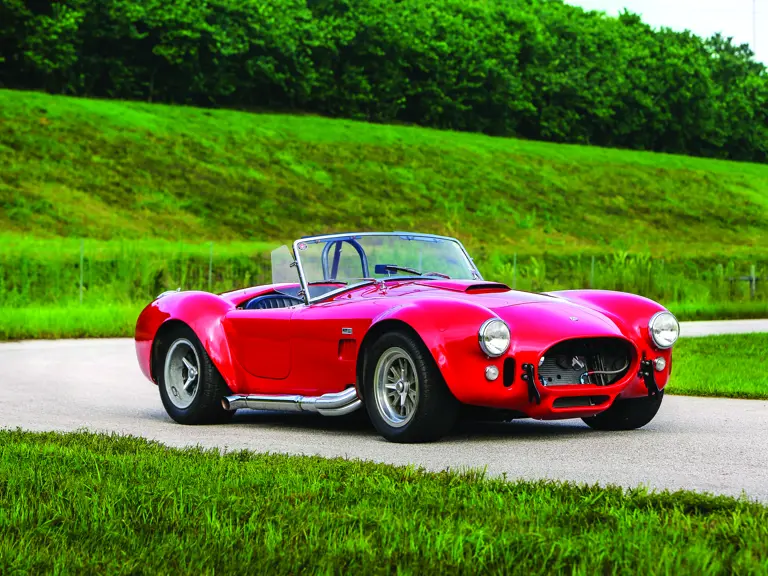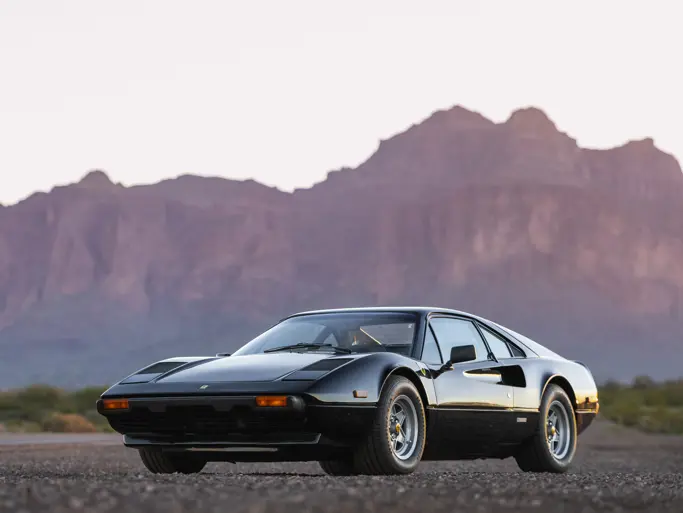
1967 Shelby 427 Cobra
{{lr.item.text}}
$726,000 USD | Sold
CSX3308
{{bidding.lot.reserveStatusFormatted}}
- Period-correct 427 V-8 is a cross-bolt main side-oiler
- Manual gearbox
- Shelby Registry documented
- Many professional mechanical upgrades
- Executed by Shelby expert, Chuck Gutke
- Well-used and proven in earlier vintage events
- Out of retirement, ready for action
From a child in rural Texas, Carroll Shelby developed into a pre-racing life with stints in the WWII United States Army Air Corps as a pilot and flight instructor to husband and father to dump truck business owner to chicken farmer to his beginnings at the wheel of a racecar in 1952.
Shelby developed into a world-class professional racing driver. His talent was first appreciated on a grand scale by the legendary John Wyer, then team manager for the Aston Martin team in 1954 and soon afterwards, Shelby would become part of the Aston Martin team and with them, go on to win the 1959 Le Mans 24 Hours with co-driver Roy Salvadori. Other great teams would bid for his services and he’d also race successfully for Austin-Healey, Maserati and Ferrari. After a heart ailment required his premature retirement from life as a professional race driver in 1960, he devoted himself into the business world, first as a race tire retailer for Goodyear in Southern California.
With his creation of the AC Shelby Cobra in the early 1960s, Carroll Shelby would become a worldwide phenomenon in the world of sports cars for both the road and racetrack. “Shucks,” said Shelby in a June 1965 Motor Trend article, “I’m not an engineer. I’m not even very smart. The only thing I understand is human nature. I just like to bring the right people together and see what happens. I think I’ve put the right people in Shelby American; they’re getting the job done.”
They certainly were; three years prior to this comment, the enterprise was no more than “Shelby and an answering service.” Then Shelby conceived the Cobra. All he needed were a few of these “right people and a couple of engines on the cuff.” Ford Motor Co. was committing themselves to a performance image just as he approached them; Ford gambled on the Texan’s venture and the Cobra was an instant success on the racetracks and soon orders poured in.
The raves from enthusiast magazines poured in immediately; this same enthusiasm followed with the introduction of the later 427 version - not only based on the 427 Cobra’s sprint abilities, but also handling, braking and outright speed. In the 1950s, Aston Martin caught the public’s attention by promoting their grand touring car with the rating that it could accelerate from 0- to 100-mph and then return to a dead stop in less than 25 seconds. An impressive number in its day when most cars couldn’t reach the 100-mph mark; period. Then the Cobra came along and set numbers that are still to be measured by today.
The November 1965 issue of Car and Driver magazine summed it up beautifully:
“Several years ago, the manufacturers of a posh British grand touring car got a fair amount of mileage out of the claim that their vehicle could accelerate from 0– to 100-mph and brake to a complete stop in less than 25 seconds.
This was indeed an impressively brief period of time during which all that change of velocity happened, but automotive development has come a long way since then and today perhaps half a dozen production cars of one kind or another can perform on that level. What's more, there are several automobiles being produced in the United States that will break through that arbitrary 25 second barrier. One is the 427 Sting Ray; another, most certainly, is the new 427 Cobra from Shelby American.
Alright, you say, if 25 seconds from 0–100–0 isn't so hot anymore, what is? Twenty seconds?
Forget twenty seconds.
How about 18 seconds?
Not too bad, but the Cobra can do better.
How much better, wise guy?
How about maybe 14.5 seconds? Get that, 14.5 seconds to accelerate to 100 miles an hour and then stop again. Until something better comes along, that may have to stand as some sort of high water mark in performance for cars that are readily available to the general public. That figure, mind you, is obtainable by the average Cobra driver with the regular 8.15 x 15 Goodyear Blue Dot street tires. Cobra test driver Ken Miles has done the job in as little as 13.8 seconds, and who knows how much improvement could be made with racing tires that would nullify some of the tremendous wheel spin?
The 427 Cobra does accelerate and decelerate at unbelievable rates, as the above figures should imply. What's more, it is a more civilized machine than the original 289 Cobra that brought the fabulous Shelby organization into being four years ago. It handles properly, thanks to a completely new all-independent suspension system that is traceable to the deft hand of Klaus Arning, the Ford Motor Company genius responsible for the impeccable handling of the Ford GT.”
Today this remains a time measure that magazines use in testing cars like Lamborghini, Viper and Porsche against; even with Z-rated tires they have a hard time equaling Ken Miles’ 427 Cobra record.
Even the top cars have to evolve to stay at the sharp end of the grid in competition. Already the fiercest snake on four wheels with the 289-cid V-8, by 1966 the AC-produced, Shelby-built Cobra now had exclusive use of the big-block 427-cid V-8 with 425-hp. Modifications came with a longer and wider chassis and revisions also applied to the suspension, wheels, tires, plus other components were fabricated to accommodate the extra muscle.
The 427 Cobra utilized an all-independent coil-spring suspension with a large-diameter steel tube frame. Aluminum bodies were formed over lightweight steel-tube formers and provided a tremendous power-to-weight ratio. Four-wheel disc brakes slowed the beast in an excellent manner and a limited-slip differential helped apply the power to the ground. Among the standards for the Cobra 427 were a Ford four-speed synchromesh gearbox, leather bucket seats, tinted sunvisors and windwings.
Of course, Cobras are few in few numbers, and the 427 version, coil spring cars production numbers are listed in the fourth edition of the “World Registry of Cobras & GT40s” as totaling 343 cars in seven categories with “Street Cars” topping the list with 260 produced. Also according to the Registry, CSX3308 was billed to Shelby American on August 24, 1966. Shelby invoice #3504, dated May 26, 1967, billed Stark Hickey Ford, Inc. in Royal Oak, Michigan for a total of $6,289, including freight charges and less $150 for “incomplete paint.” The Cobra’s first owner is unknown, but he is reported to have rolled the car in his first year of ownership. It was then said to have been stored in a barn with 1,500 miles on the odometer until being discovered and purchased in 1974. The car was restored at that time.
Then again in the early 1980s, CSX3308 was restored by Cobra Restorers in Kennesaw, Georgia – this time with an alloy skin from Brian Angliss of Surrey England. In the 1970s and ‘80s, there was a very popular movement amongst select owners to apply the “S/C competition look” to their street Cobras. If you’ve ever studied the photographs of the factory Shelby Cobras in the height of their battles on the world racing stage against arch-rival Ferrari; you’ll understand the lure.
During this restoration the Cobra was repainted in red and given the competition-spec look with chromed header side pipe exhaust system, a black rollbar, hood scoop, a competition “quick-fill” fuel filler and knock-off Halibrand wheels. The Cobra has a Holley 715-cfm carb, wood-rimmed steering wheel with AC center cap, Smiths instrumentation, Talbot Yorck sport mirror and BFGoodrich Comp T/A tires.
No expense was spared in the pursuit of optimum performance and reliability as Cobra expert Chuck Gutke made upgrades to the car’s manual transmission, brakes and cooling system to have a 427 Shelby Cobra that could be the class of the field, whether in high-speed vintage competitions or being able to fully extend its savage potential to road touring events. Numerous badges on the dash and firewall illustrate the history of CSX3308 and its participation in vintage moving events. The Cobra ran these events from 1979 to 1983 at such renowned circuits as multiple events at Road Atlanta and Sebring, plus Shelby American Automobile Club participation at the Utica Proving Grounds and Dearborn.
The period-correct 427 V-8 is a cross-bolt main side-oiler that has a casting date of March 11, 1966. Additionally the Cobra has an aluminum dual-plane intake, remote oil filler with oil cooler, FoMoCo aluminum cylinder heads, Accel dual-point ignition, nylon suspension bushings, cast-iron scatter shield, 36 gallon fuel tank, Koni coil-over shocks, front swaybar and four-piston competition brake calipers. This Shelby was well-used and proven during the 1979 to 1983 period when it spent a great deal of time on and off the track before being retired.
Surely one of the burliest, meanest-looking automobiles ever offered, the Cobra is a beautiful combination of all that is exciting in open-road sports motoring while enjoying legendary American power and reliability. Since its inception, the 427 Cobra has been considered to be one of the America’s greatest automotive creations, and time has proven this true. In particular, the 427’s performance and power was nothing short of legendary in its day, and its performance figures still compare favorably with the current crop of sports cars.
This is a machine that is right at home on the road or the track. When you include destinations like Road America or Watkins Glen; you’ll be able to stretch its legs on the legendary permanent courses and then experience the original street circuits and ambiance that helped revive American sports car racing after World War II. What better way to experience thrills like this than in a 427 Cobra?
Now it’s your turn to take the wheel and apply the car’s strengths to your own and experience one of the fiercest –looking, driving and awe-inspiring sports cars ever built. Now taken out of retirement and ready to thrill a new audience; this Cobra is set to be enjoyed by its next caretaker; every fiber of your being will thank you.


 | Hilton Head Island, South Carolina
| Hilton Head Island, South Carolina


